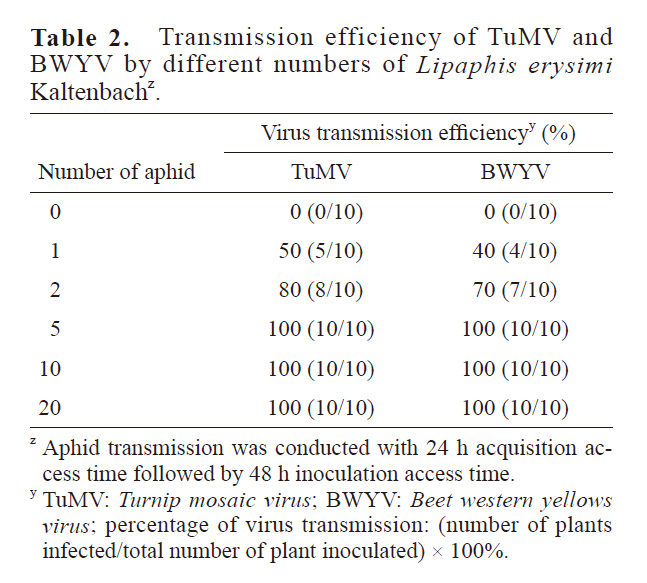All issues
Author:Li-Yu Tsao
Abstract:
Symptoms of suspected virus infection in cruciferous vegetable fields mainly include symptoms of leaf mosaic, mottle, yellows, vein necrosis, vein enation, and stunting. This study used virus sera of Beet western yellows virus (BWYV), Cauliflower mosaic virus (CaMV), Cucumber mosaic virus (CMV), Radish mosaic virus (RaMV), Turnip mosaic virus (TuMV), Turnip ring spot virus (TuRSV) with indirect enzyme-linked immunosorbent assay (indirect ELISA) to investigate the infection ratio of different viruses in the simple facilities. Among them, the detection rate of 6 viruses was the highest with TuMV, followed by BWYV. The most effective mixed-virus infections were BWYV and TuMV. The above 6 sera and indirect ELISA analysis were also used to detect seed grinding liquids of a total of 27 varieties and 40 lots of cruciferous vegetables, including heading Chinese cabbage, non-heading Chinese cabbage, cabbage, rape, mustard, Chinese kale, cauliflower, broccoli and radish. Results showed that no virus was detected. The leaf mustard or leaf radish inoculated with the TuMV single-spot isolated strain or BWYV by artificial inoculation method was used as a source of virus for the turnip aphid (Lipaphis erysimi Kaltenbach) to study the transmission characteristics. Symptoms appeared after 10 d of inoculation when a radish leaf was inoculated one turnip aphid with TuMV. The TuMV transmission efficiency can reach to 100% when 5 aphids were inoculated at the same time. When the acquisition and inoculation temperature of turnip aphid was at 25℃, the virus transmission efficiency can reach 100%. The transmission efficiency can reach 100% when the acquisition access time for aphids was 10 min. The virus transmission efficiency reached 100% when the aphid inoculation access time was 60 min. By inoculating BWYV isolates with artificial inoculation as a source of virus for turnip aphid, the efficiency of virus transmission can reach 100% when 5 aphids with BYWV were used to spread the virus. As the acquisition temperature of turnip aphid was set at 20℃, the virus transmission efficiency can reach 100%. When the inoculation temperature was 25℃, the virus transmission efficiency can reach 100%. The transmission efficiency can reach 100% when the acquisition access time was more than 48 h. Using pakchoi leaves to test 8 commonly insecticides found in the market, the aphids control rate can reach 87% or more after spraying 24.7% Thiamethoxam + Lambda-cyhalothrin suspension concentrates (SC), 16% Clothianidin soluble granules (SG), 25% Thiamethoxam SG, 20% Dinotefuran SG, 1% Milbemectin emulsifiable concentrate (EC), 20% Acetamiprid soluble powder (SP), 18.2% Imidacloprid SC, and 50% Cartap SP for 48 h, respectively. Non-pesticide control plant protection materials such as detergents and oils were used to evaluate the control effect on aphids, it showed that the better aphid control rate was found by spraying with 50× of 35% soap tree concentrate and 300× of 99% mineral oil.
Key words:Cruciferous vegetable, Turnip mosaic virus, Beet western yellow virus, Aphid transmission
Download:![]() PDF Links
PDF Links
- 1. Development of Tractor-Mounted Seedling Transplanter for Sweet Potato
- 2. Synergistic Effect of Additional Gas on the Toxicity of Phosphine to Sitophilus oryzae and Sitophilus zeamais (Coleoptera: Dryophthoridae)
- 3. Effects of Temperature and Solar Radiation on Growth Traits and Plant Elements in Purple Leafy Sweet Potato

 Submit your manuscript
Submit your manuscript
 Guide for authors
Guide for authors